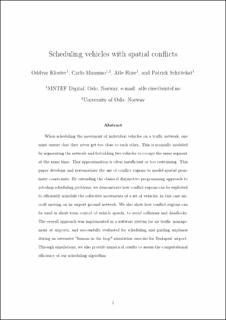| dc.contributor.author | Kloster, Oddvar | |
| dc.contributor.author | Mannino, Carlo | |
| dc.contributor.author | Riise, Atle | |
| dc.contributor.author | Schittekat, Patrick | |
| dc.date.accessioned | 2023-02-23T12:19:54Z | |
| dc.date.available | 2023-02-23T12:19:54Z | |
| dc.date.created | 2021-11-15T09:45:15Z | |
| dc.date.issued | 2022 | |
| dc.identifier.citation | Transportation Science. 2022, 56 (5), 1165-1178. | en_US |
| dc.identifier.issn | 0041-1655 | |
| dc.identifier.uri | https://hdl.handle.net/11250/3053594 | |
| dc.description.abstract | When scheduling the movement of individual vehicles on a traffic network, one must ensure that they never get too close to one another. This is normally modelled by segmenting the network and forbidding two vehicles to occupy the same segment at the same time. This approximation is often insufficient or too restraining. This study develops and systematises the use of conflict regions to model spatial proximity constraints. By extending the classical disjunctive programming approach to job-shop scheduling problems, we demonstrate how conflict regions can be exploited to efficiently schedule the collective movements of a set of vehicles, in this case aircraft moving on an airport ground network. We also show how conflict regions can be used in the short-term control of vehicle speeds to avoid collisions and deadlocks. The overall approach was implemented in a software system for air traffic management at airports and successfully evaluated for scheduling and guiding airplanes during an extensive human in the loop simulation exercise for the Budapest airport. Through simulations, we also provide numerical results to assess the computational efficiency of our scheduling algorithm. | en_US |
| dc.language.iso | eng | en_US |
| dc.publisher | INFORMS | en_US |
| dc.title | Scheduling Vehicles with Spatial Conflicts | en_US |
| dc.title.alternative | Scheduling Vehicles with Spatial Conflicts | en_US |
| dc.type | Peer reviewed | en_US |
| dc.type | Journal article | en_US |
| dc.description.version | acceptedVersion | en_US |
| dc.source.pagenumber | 1165-1178 | en_US |
| dc.source.volume | 56 | en_US |
| dc.source.journal | Transportation Science | en_US |
| dc.source.issue | 5 | en_US |
| dc.identifier.doi | 10.1287/trsc.2021.1119 | |
| dc.identifier.cristin | 1954482 | |
| dc.relation.project | Norges forskningsråd: 267554 | en_US |
| dc.relation.project | Norges forskningsråd: 237718 | en_US |
| cristin.ispublished | true | |
| cristin.fulltext | postprint | |
| cristin.qualitycode | 2 | |
